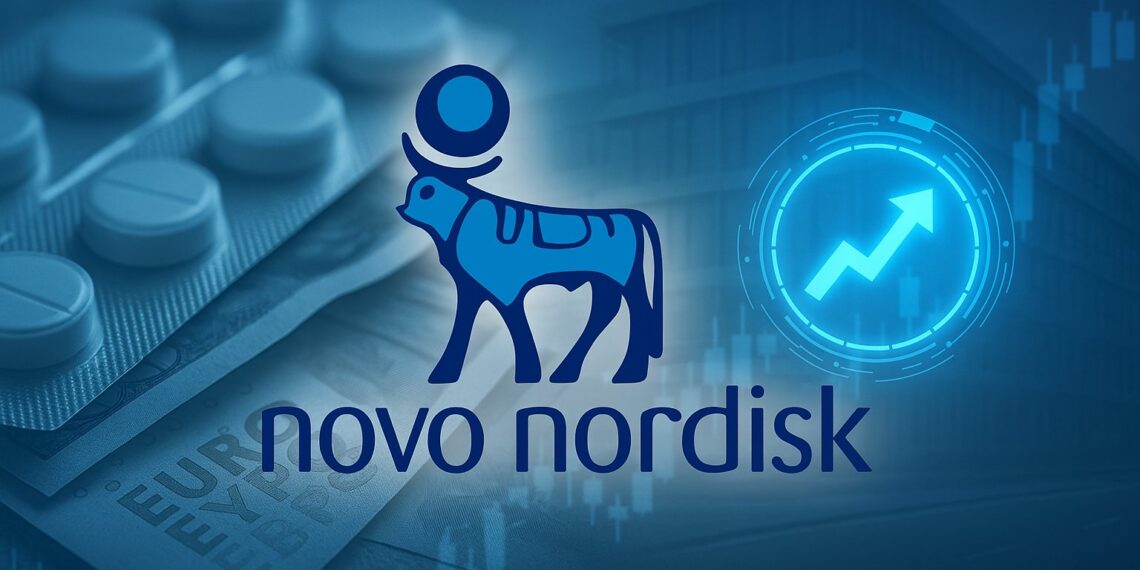The Novo Nordisk stock (NYSE: NVO) has long been a favorite among health care investors — but the once-unshakable Danish giant is showing signs of vulnerability. After years of relentless growth fueled by its blockbuster weight-loss and diabetes drugs, Wegovy and Ozempic, the company is now facing a tougher reality: capacity constraints, political risks, and rising competition are testing investor confidence.
2025 has become a year of adjustment and recalibration. The hype around “miracle weight-loss drugs” has cooled, while new risks such as potential U.S. import tariffs on branded drugs and regulatory headwinds weigh on sentiment. Novo Nordisk remains a global heavyweight in metabolic medicine — but the question is no longer how high it can fly, but how well it can stabilize.
This analysis explores where Novo Nordisk stands now, how its fundamentals are evolving, and whether the stock’s pullback could be setting the stage for a new phase of sustainable growth.
1. From Market Darling to Industry Survivor
For years, Novo Nordisk was seen as Europe’s success story — a pharmaceutical innovator that transformed from an insulin specialist into a global force in diabetes and obesity care. With its GLP-1 drugs Ozempic and Wegovy, the company built a dominant position in one of the most profitable and fastest-growing sectors in medicine.
But after several years of near-perfect execution, cracks have begun to show. Demand for Wegovy remains sky-high, yet production capacity has struggled to keep up. Shortages have frustrated patients and physicians alike, and even with new manufacturing facilities ramping up, supply chain issues continue to limit growth potential.
Meanwhile, rival Eli Lilly is aggressively expanding its own GLP-1 portfolio, taking market share and driving a pricing battle that Novo can no longer ignore.
2. Stock Performance: From Record Highs to Cautious Consolidation
The Novo Nordisk stock reached record highs in late 2024 and early 2025, peaking above $130 per ADR, driven by enthusiasm over Wegovy’s rapid adoption. Since then, however, the stock has cooled considerably.
As of October 2025, the share trades around $59–60, down roughly 10% from its summer highs. In euro terms, it fluctuates near €50–51 on European exchanges. The company’s market capitalization remains impressive at around $260 billion, but investors are beginning to question whether the valuation fully reflects the challenges ahead.
The current market sentiment could be summarized as “cautious optimism” — acknowledging Novo’s leadership in GLP-1 therapies while recognizing that the easy growth phase may be over.
3. The Wegovy Slowdown: Growth Meets Its Limits
Wegovy remains the centerpiece of Novo Nordisk’s strategy — but the company’s meteoric rise has been constrained by the very success of its flagship product. Demand continues to outpace supply, and several regions still face persistent shortages.
In 2025, management admitted that production capacity and raw material bottlenecks had delayed shipments. Although new plants are being built in Denmark and the U.S., scaling such complex biopharmaceutical production takes time.
Wegovy’s oral tablet version — seen as the next major breakthrough — has yet to deliver the anticipated momentum. Approval timelines and launch logistics have taken longer than expected, frustrating investors who hoped for a new wave of revenue acceleration.
4. Ozempic Under Pressure
While Wegovy drives the headlines, Ozempic, Novo’s diabetes blockbuster, remains a key source of cash flow. However, even here, growth is slowing.
Competition from Eli Lilly’s Mounjaro and the newer Zepbound is intensifying, and insurance reimbursement rules in the U.S. have become stricter. Price negotiations and government-led cost-control initiatives have begun to squeeze margins.
For Novo Nordisk stockholders, this means the once-clear story of double-digit growth is now being replaced by questions of margin preservation and operational discipline.
5. U.S. Tariff Fears: The “Drug Shock” Scenario
One of the biggest risks currently hanging over the sector is the discussion of potential 100% import tariffs on branded pharmaceuticals entering the United States.
As a European manufacturer with massive exposure to the U.S. market, Novo Nordisk would be among the companies most affected if such measures were implemented. The company is exploring local production options, but even partial tariffs or trade restrictions could put pressure on profits and complicate logistics.
Although analysts still see the tariff scenario as unlikely in its most extreme form, the uncertainty has clearly affected market sentiment. The Novo Nordisk stock has become more volatile as investors try to price in these political risks.
6. Telehealth Expansion: Digital Promise, Practical Hurdles
In response to shifting market dynamics, Novo Nordisk is pivoting toward digital healthcare and telemedicine. The company’s strategy aims to integrate online prescription platforms and digital patient engagement tools into its sales model.
In theory, this move could dramatically expand patient reach — especially in the U.S., where telehealth services make it easier to access treatment without in-person visits. Novo Nordisk’s partnerships with major health-tech platforms are designed to simplify the prescription process and improve medication adherence.
However, implementation remains complex. Data privacy, reimbursement policies, and regulatory differences between markets pose significant hurdles. While the digital approach is promising, it is not an immediate profit driver — at least not yet.
7. Analyst Sentiment: Downgrades Replace Hype
The analyst community has become increasingly divided over the Novo Nordisk stock. After years of “buy” ratings, several major banks have recently turned more cautious.
Downgrades in mid-2025 cited concerns over valuation, competition, and policy headwinds. Analysts now highlight that growth expectations for Wegovy might have been “too optimistic,” especially considering the supply chain struggles and pricing pressure in key markets.
Still, some long-term investors maintain confidence. They argue that Novo’s pipeline, manufacturing scale, and brand recognition give it enough firepower to remain a global leader in metabolic health — even if short-term growth slows.
8. Competition: The Battle With Eli Lilly Heats Up
The rivalry between Novo Nordisk and Eli Lilly has evolved into one of the fiercest duopolies in the modern pharmaceutical industry.
Eli Lilly’s Mounjaro has captured significant share in the diabetes segment, while its obesity drug Zepbound continues to outperform expectations. Unlike Novo, Lilly has managed to expand capacity faster, giving it a temporary edge in fulfilling demand.
For Novo Nordisk, the competitive threat is not just about market share — it’s about narrative. Investors increasingly view Lilly as the “execution winner” of the GLP-1 race, while Novo is seen as the established leader fighting to regain its momentum.
9. Financial Health: Strong Balance Sheet, Slower Margins
Despite the setbacks, Novo Nordisk’s financial foundation remains robust. The company continues to generate substantial free cash flow and maintains one of the strongest balance sheets in the pharmaceutical industry.
However, profitability metrics are beginning to flatten. Operating margins, once comfortably above 40%, are showing signs of pressure as costs rise for manufacturing, logistics, and compliance. Capital expenditures are increasing as the company accelerates investments in new production lines to meet long-term demand.
In short: Novo remains financially solid, but it’s entering a phase where execution, not hype, will determine performance.
10. Valuation: From “Must-Own” to “Show Me”
At its peak, the Novo Nordisk stock traded at valuation multiples that rivaled Big Tech — with a forward P/E ratio well above 40. That premium was justified by explosive growth and global leadership in a new therapeutic class.
Now, with growth normalizing, investors are taking a more conservative stance. The P/E has compressed slightly, but the stock is still not cheap relative to the broader healthcare sector.
This means future upside will depend less on multiple expansion and more on earnings delivery — a classic shift from a story-driven stock to a results-driven one.
11. Key Opportunities Ahead
Despite short-term headwinds, Novo Nordisk still holds several significant opportunities:
- Oral Wegovy Launch: If the oral version successfully reaches the market in 2026, it could unlock a new wave of accessibility and revenue.
- Telehealth Integration: A fully developed digital ecosystem could improve patient retention and brand loyalty.
- Pipeline Potential: New GLP-1 combinations, metabolic therapies, and cardiovascular applications remain in development.
- Emerging Markets Expansion: Demand for diabetes and obesity treatments continues to grow in Asia and Latin America.
For long-term investors, these catalysts could form the basis of the next growth cycle — once the company proves it can overcome its current growing pains.
12. Major Risks to Watch
- U.S. Tariffs or Political Pressure: New trade or pricing regulations could hit margins hard.
- Competitive Intensity: Eli Lilly and potential new entrants are increasing pressure on pricing and innovation speed.
- Supply Chain Disruptions: Any further delays in production expansion could limit revenue growth.
- Valuation Risk: High expectations leave little room for disappointment.
- Reimbursement Challenges: Governments and insurers are tightening cost controls on expensive therapies.
13. Technical Picture: Stabilization in Sight
Technically, the Novo Nordisk stock is in a consolidation phase. After peaking earlier in the year, the stock corrected roughly 15% before finding support near $58.
Short-term volatility remains high, but the overall trend is stabilizing. For technical traders, the key resistance lies around $62, while support levels sit near $55 and $50. Long-term investors see these ranges as potential entry zones for gradual accumulation.
14. Investor Outlook: From Momentum to Maintenance
For much of the past three years, Novo Nordisk has been a momentum stock — a name investors chased because of its unstoppable growth narrative. Now, it’s entering a more mature phase.
The company must prove that it can sustain high profitability in a more competitive, politically sensitive environment. The focus for 2026 will be on efficiency, capacity management, and the successful launch of new formulations.
Earnings scheduled for November 5, 2025, will be the next major checkpoint. Guidance updates, commentary on production scaling, and U.S. policy developments will set the tone for the months ahead.
15. Conclusion: Still a Leader — But With Something to Prove
The Novo Nordisk stock remains one of the world’s premier healthcare assets — but the easy part of the story is over. The company is transitioning from explosive growth to sustainable performance, and that shift will test both management and investor patience.
While the fundamental case for long-term growth remains intact, the near-term path looks more like a recovery storythan a runaway success. Execution, cost discipline, and adaptation to policy realities will determine whether Novo Nordisk can reclaim its reputation as a dependable growth engine.
For long-term investors, the stock still offers structural exposure to one of the most important medical revolutions of the decade. But from here, it’s all about delivery over promises.
FAQ – Novo Nordisk Stock
What does Novo Nordisk do?
Novo Nordisk develops and sells treatments for diabetes, obesity, and rare endocrine disorders. Its main products are the GLP-1 drugs Wegovy and Ozempic.
Why did the stock pull back?
After years of exceptional growth, investors are pricing in slower sales, supply constraints, and rising competition.
Is Wegovy still growing?
Yes, but at a slower pace. Production bottlenecks and distribution delays have tempered the growth rate.
What is the telehealth strategy?
Novo Nordisk is expanding digital access through online prescription and telemedicine platforms to reach more patients and improve adherence.
What’s the biggest current risk?
Potential U.S. import tariffs on European-made drugs and political pressure on drug pricing.
Is Novo Nordisk stock still a buy?
For long-term investors, it remains a quality company with structural tailwinds — but the short term may stay volatile as it recovers from recent challenges.







